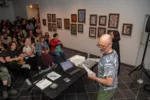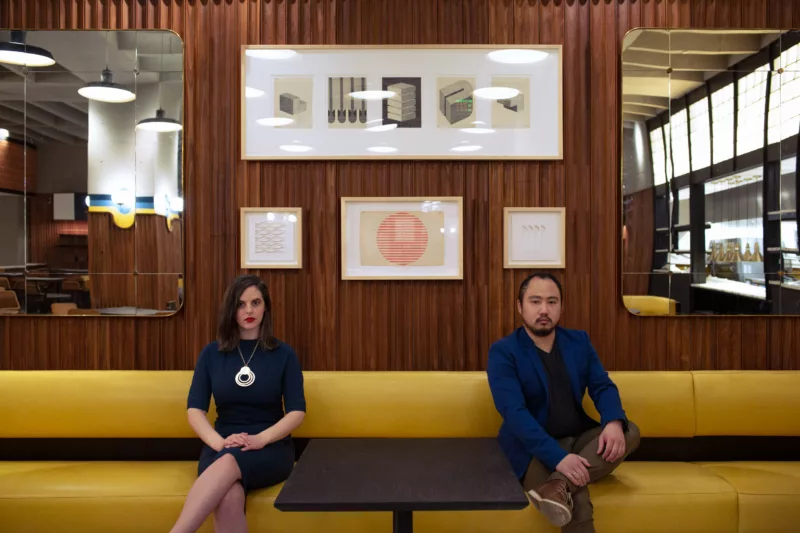
INTRODUCTION
Elizabeth interviewed Sara McCorriston, co-founder (with Jason Chen) of Paradigm Gallery and Studios via Zoom, then transcribed their conversation. Both Elizabeth and Sara edited, improved and fact-checked content after the initial conversation.
Elizabeth Johnson: Tell us about what came before owning a five-story, 7,000 square foot gallery, and celebrating 14 years in business.
Sarah McCorriston: We opened in 2010 on South Street, in a 350 square foot studio space that Jason Chen and I shared. He used the first-floor open space for photography, and I was sewing in the basement. We decided that we had these walls, we know so many talented Philadelphia artists, we should show their art. So, we started having monthly exhibits, but we both had full time jobs and the gallery was open only on the weekends.
Elizabeth: What kind of jobs?
Sara: I was a technical designer for Urban Outfitters, doing pattern work, though my degree from the University for the Arts is in Theater Design. Jason and I met there, he studied photography and video and ran the print lab. I studied costume, lighting and set design. All these skills come in handy at a gallery. I also have an intense love for numbers. We soon figured out that he was better managing the aesthetic of the gallery, handling documentation, postcards, and videos, and I was better with the business end, but we curated shows together. We had other jobs too: Jason worked for Trevor Dixon, and I was a public school teacher and did part time stage management and design for theater and dance for a while.
From the beginning we paid for the gallery from our paychecks. By 2014 we were still not getting paid by the gallery, except sometimes commissions. I was working full time with side jobs and got pneumonia and all I could do was type on my laptop in bed. We started selling more work online, and later could quit our jobs. The timing was right to work on a laptop from home. We were young and starting a new business when Square credit card swiping was just getting started, point of sale systems were becoming cloud based, and online sales were very new for galleries. New technology dovetailed with our goal of making art accessible for everyone.
Elizabeth: Is this how you got involved in international sales?
Sara: We were on Instagram from the beginning, as were so many of our artists. I give a lot of credit to creative partnerships with art blogs and magazines, such as, The Artblog, Root Quarterly, Create Magazine, Juxtapoz, Colossal, Jealous Curator, Streets Dept, HAHA Magazine, and many others. Root Quarterly and Create Magazine rent space at Paradigm for special events and exhibitions: Create Magazine presents two art exhibits a year in the gallery.
Elizabeth: It sounds like you did your research.
Sara: Then everything shifted during the 2008 financial crisis: people lost jobs, homes, and all sense of stability. Entering the job market was all risk. We were all on a mission to find cheap rent. I was working eighty to ninety hours a week, so I at least wanted to like what I was doing. We found unpretentious collaborators like us. Jason and I had undergraduate degrees for things other than running a gallery, but we worked hard and invited other people in.
Elizabeth: How are you cultivating long term loyalty and shared vision with your artists and tenants?
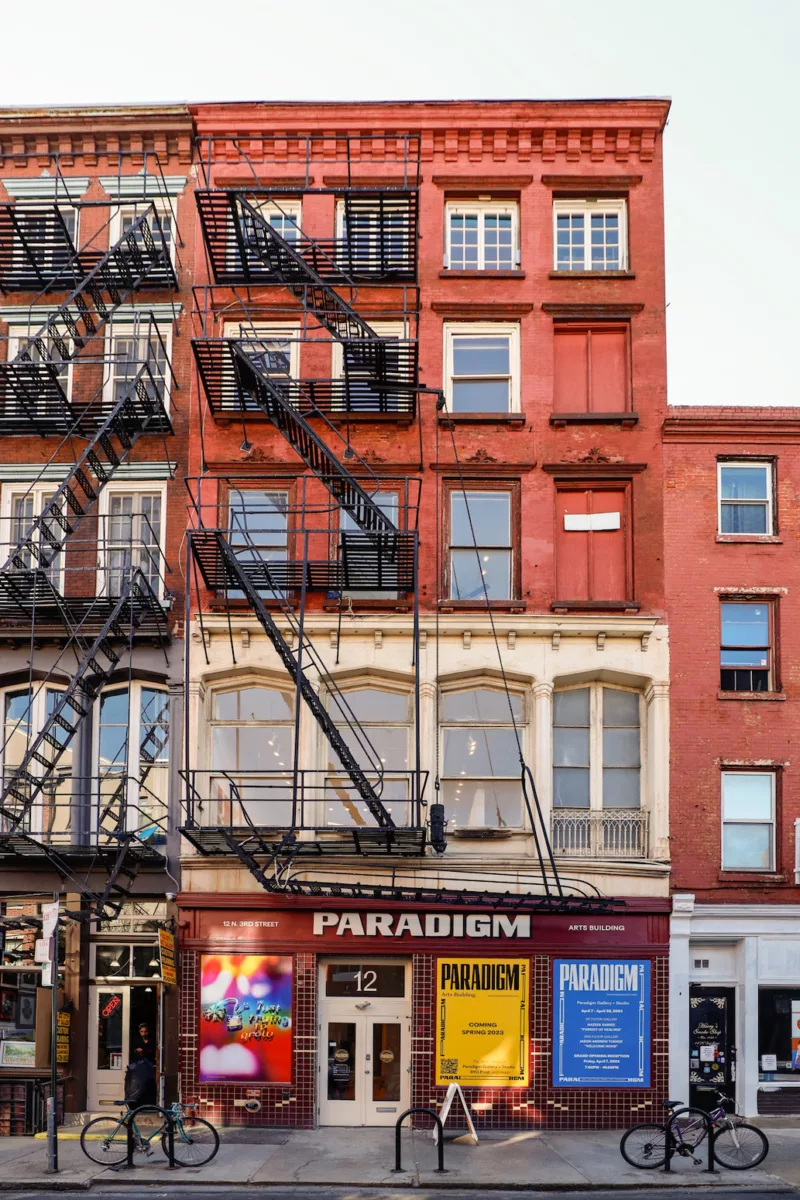
Sara: We have had to earn the loyalty of our artists and collaborators. They tell us they know how hard we work. We all started out making art on the weekends and having full time jobs, then got part time jobs to make art during the week. We have figured out how to be full time together and our space reflects this.
Each time we have moved it has been because our building has sold. Our second space was on Fabric Row, in Queen Village; it felt right to be part of this diverse, small business community near where Jason grew up. Both Jason and I come from families that understand small business. With each move and like when we quit our day jobs, we said, “We’re really a gallery now!” Our third space at Fourth and Fitzwater was 1,200 square feet, another huge shift, and a moment for reflection. Our artists were ready and deserved an impressive place to show in Old City and we wanted to give it to them.
Since we were expanding, regular moving (as renters) presented the risk of getting put out of business, so we made the scary, uncomfortable leap to buying our current five-story, 7,000 square foot, building in 2022. Since then, we have two full time employees with healthcare, Jessica Aguilar and Paddy Magdon, and have made ourselves full time employees.
Elizabeth: Is there a limit to how many artists you can serve? Are you taking submissions?
Sara: Submissions are free and always open, and we meet quarterly to consider work that would fit into any of several income-earning streams. I must add that we look at everything submitted but can’t reply to everyone.
We have a stable of eight to ten artists that get solo exhibits every 18-24 months,
some we’ve known over a decade. But we also work slowly building the careers of so many more artists. Usually, we’ll start off looking at work and then curate new artists into a group show and see how it goes. We also can do a collection release of five to 20 pieces online. The idea is to build the audience, gallery, and artist relationships together.
Elizabeth: What do you tell new artists to expect?
Sara: We’re collaborating earlier and more efficiently with our artists. Most importantly, we are checking in and doing studio visits with them more often and posting about it. We stay involved in what is going on in their life. Is there a non-profit show we can help manage? We build lists and post on social media together: it’s more difficult than ever to break through in social media.
Elizabeth: So, you are managing artist’s careers, there’s a big need for this kind of support. Artists are always influenced by what sells. If an artist develops slowly, they’re less likely to be insecure, it’s more practical. If an artist grows too fast they might lose faith in what they are making and give up altogether.
Sara: Organic growth is important for the audience as well. If buyers already know the artist
they are more welcoming of new, perhaps bigger and riskier work, and they are more likely to continue to support the artist.
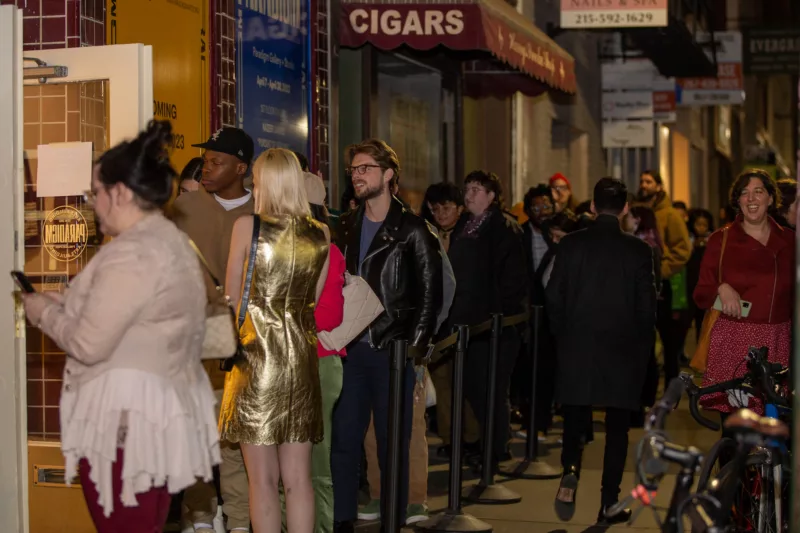
Elizabeth: Who comprises your audience? How do you structure a sale?
Sara: Our audiences are separated into categories. There are the people we reach on Artsy and 1stDibs, those that follow art fairs, Philadelphians, people we connect with on social media, audiences specific to each artist, and we get a walk-in crowd of Old City tourists who explore our gallery shop, looking for small pieces to take home in their suitcase.
The artist always gets fifty percent, so even if we are sharing a sale with another gallery, the artist gets their full share. We may use an artist for an art advisory project, and their work would end up in a hotel, restaurant, or apartment complex. We set up commissions for artists or manage commissions that they bring, so the percentages change based on how we support the artist through doing paperwork, invoicing, and correspondence for them. We work a lot with other galleries and are set up to handle storage, shipping, and international documentation for them. Most artists and galleries are relieved that we do this background work. I really love numbers, Excel, spreadsheets. Everything we do, I do the math first.
Elizabeth: What art fairs do you participate in?
Sara: The L.A. Art Show, Scope Miami during Art Basel, and Art on Paper in New York.
Elizabeth: So, you’re getting away from the “white box” model that is more forbidding to buyers. All that empty space is cold and makes an artist feel exposed.
Sara: I don’t even feel comfortable in some art galleries, and I own one! People buy at Paradigm and tell us that they’ve never collected art before; they buy a two or three-dollar sticker, and we say, “Welcome, and Thank You for being a Paradigm collector!” That’s why it’s important always to have something accessible for sale in the gallery, we want to make that moment happen easily.
Our most successful way of engaging with the community is our art classes. It’s so cool to see somebody who was outside, hanging around, reluctant to try–come in and start making art. Usually, if they see kids having fun, they’ll join in. We pay the artists to teach them and buy materials from funds raised in our annual auction of all the art produced. So, you make something, but leave it with us to be sold. People return to buy their own work or buy other people’s work –, it’s so exciting if someone likes your piece.
Elizabeth: I notice your “New Type of Granny Square ” workshop sold out. Tell us about it.
Sara: There’s such a desire for something like this in Philadelphia. So many people attend our workshops and so many sell out. We are bringing big, international art names to teach here,
and we want to continue being a hub of art activity, a destination.
Elizabeth: Have artists started to “outgrow” Paradigm yet? It’s natural that some will move on.
Sara: So far, we haven’t had many artists leave. We show people who have become big names, and we don’t want to restrict them. For the most part we talk through what they need, and what we can do so they can grow and still be a part of Paradigm. As a hometown gallery for Philadelphia artists, we can collaborate with mid-level and mega-galleries who value our involvement. For example, a European artist can send us a crate of work, we show some and manage inventory and shipping to their New York Gallery. The exhibition at Paradigm reaches a different audience than the larger gallery and everyone benefits from efficiency.
Elizabeth: Sounds like lots of organizing!
Sara: I am trying to learn to delegate and focus on the bigger picture; it’s hard for me
to step away from duties. We will be remodeling the top two floors of the building, and I can’t be a construction manager and project manager, and now we are landlords!
Jessica now handles P.R. and curating and writing for exhibitions. She does artist interviews and keeps up with other gallery exhibitions. Paddy does the packing and shipping, and presentation videos and editing. They manage special events. They work together on art handling, inventory organization and exhibition turnover. We rent four off-site, temperature-controlled storage units, so there’s lots of inventory to track. Project management software was recommended to us, and it sure has made things easier. We usually sell more after a show comes down and do lots of online sales, so videos and art documentation are important.
Elizabeth: Who manages the Paradigm Art Advisory?
Sara: We’re really passionate about art advisory and share projects. I’m doing most of the planning and selection and Jason is doing most of the installation. We especially love hotels and restaurants because of their current emphasis on more unique, bespoke, and experiential interiors.
Elizabeth: Does Paradigm have a programming aesthetic? Do you seek guest curation projects?
Sara: For our programming aesthetic, collaboration, and process, are two huge words that we like to revolve whatever we’re curating around. Be it a gallery exhibition or a multi-faceted art dinner with music and performance, we’re always looking for people dedicated to their craft in whatever form that may be.
We’re fortunate to have an incredible community that allows us to participate in a lot of guest curation. We believe that collaboration allows us to expand our audience, while bringing different perspectives and points of view into Paradigm and its programming. Just like how we love bringing in new collectors and artists into our space, we love bringing in new curatorial voices. It’s something that museums do often, but I don’t see galleries doing as much. Ginger Rudolph has curated at least one exhibition a year at Paradigm for many years, and we’ve actually recently increased that number to two annual exhibitions. Especially now that we have multiple gallery floors, it would be almost impossible for Jason and me to accomplish everything we already do without the help of guest curators. We’re lucky to work with guest curators who have been in our realm for a long time and though we’re not actively seeking new guests, it’s not to say that we aren’t expanding the program. We just love the experience of working with people who dedicate so much of their time cultivating relationships, while becoming so knowledgeable in their spaces. We think it’s incredibly important and beneficial for all parties involved and has really started some beautiful new artist relationships for us.
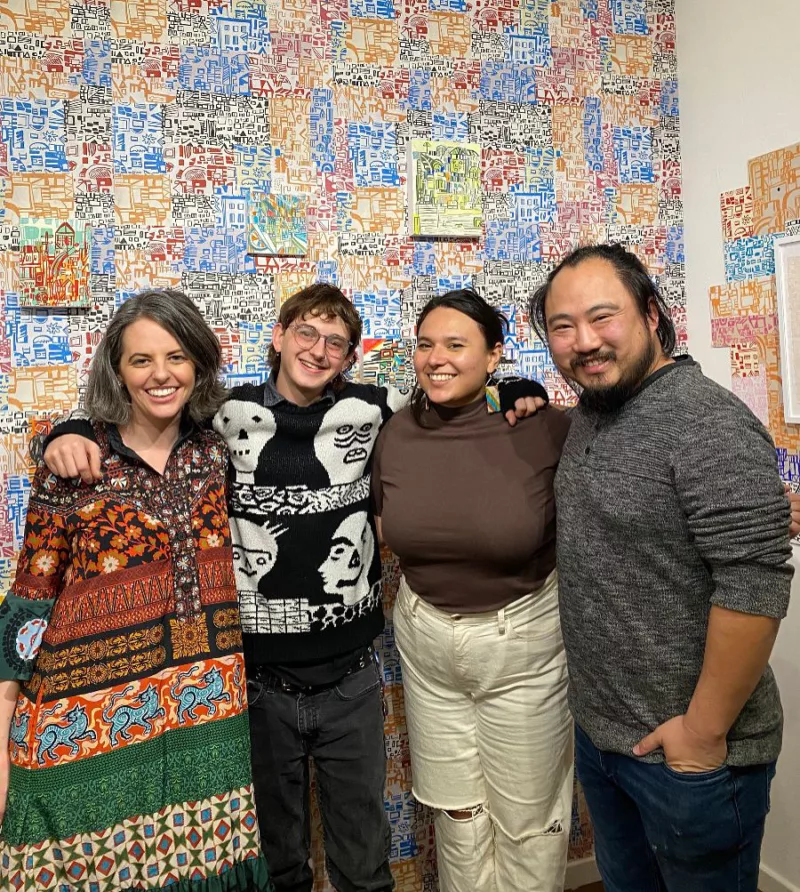
Elizabeth: Have you made a million dollars a year yet?
Sara: Yes, and we had a big celebration about it!
Elizabeth: What’s coming up in the future?
Sara: We’ve just started remodeling the fourth and fifth floors, which is really going to allow our vision to grow and expand our audience. We’ll have more space for workshops, classes, and gatherings. Right now, rentals on the 3rd floor have brought new people through the space on the way to their board meeting, yoga class or art dinner. Mural Arts consistently holds events and exhibitions here. We’ve been working with Ginger Rudolph of HAHA magazine since the very early days of Paradigm and share a public art program called HAHA x Paradigm, that will have dedicated space on the 4th floor. BYO Print and Butterfield Editions will both be on the upper floors. And as a matter of fact, two hundred years ago, our building was a wallpaper factory and showroom, so we are continuing that history by making artist-designed wallpaper with these in-building studios. Our focus is on supporting the full life cycle of artists. We’re not just setting artists up for success but supporting them throughout their entire careers. When people think about art in Philadelphia, we want them to think of the Paradigm Arts Building.
For more Artblog coverage of Paradigm Gallery and Studios, we suggest
Roberta’s 2015 interview with Sara, Jason and Ginger
Michael Lieberman’s 2020 touch base with Philadelphia galleries during Covid
Corey Qureshi’s 2023 review of Branche Coverdale’s exhibit at Paradigm




